|
Notice: This page contains information for the legacy Phidget21 Library. Phidget21 is out of support. Bugfixes may be considered on a case by case basis. Phidget21 does not support VINT Phidgets, or new USB Phidgets released after 2020. We maintain a selection of legacy devices for sale that are supported in Phidget21. We recommend that new projects be developed against the Phidget22 Library.
|
OS - OS X
| On OS X, Phidgets can be either plugged directly into a USB Port or run over a network using the WebService. |
Phidgets are designed to run on OS X 10.4 Tiger or newer, and can run on PPC, 32-bit, and 64-bit systems.
Quick Downloads
If this is your first Phidget, we highly recommend working through the Getting Started guide for your specific Phidget device, which may be found in its user guide. If you already have the Preference Pane Installed and know how to use it, then you've already followed the guide and are ready to learn more about the workings behind the Preference Pane, the Phidget WebService, and more - all specific to OS X.
If you are already a pro, and just want the drivers:
Getting Started with OS X
Installing
The Phidget installer will install the core Phidget files onto your system.
To install the libraries, follow these steps:
1. Download the Phidget installer for your system:
2. Open up the installer, and double click on Phidgets.mpkg to install the libraries.
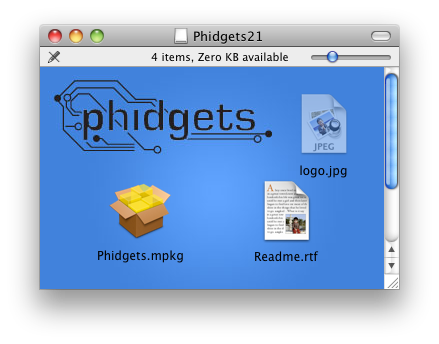
3. Proceed through the wizard.
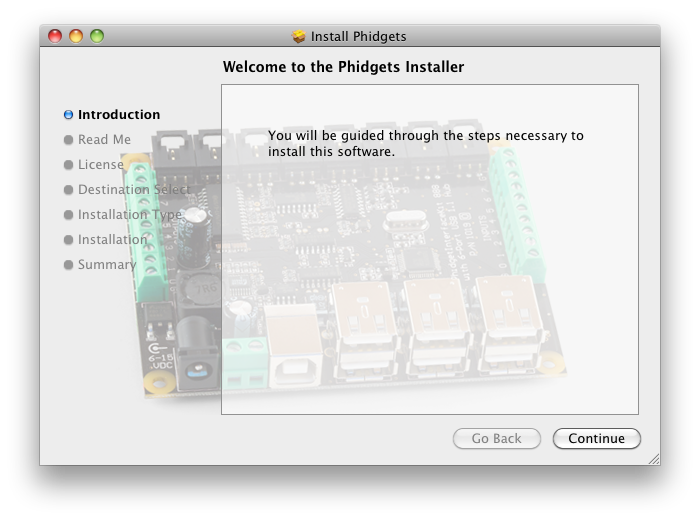
4. Once the installation is complete, you are ready to program with Phidgets. To find out what files got installed, please see Description of Installer files in the Appendix section.
Proceed onto to the next section where the Phidget Preference Pane will be discussed.
Phidget Preference Pane
The Phidget Preference Pane is a tool to quickly determine whether your system is able to communicate with Phidgets, and also act as a debugging tool.
Once the Phidget libraries are installed using the installer, open up the System Preferences window.
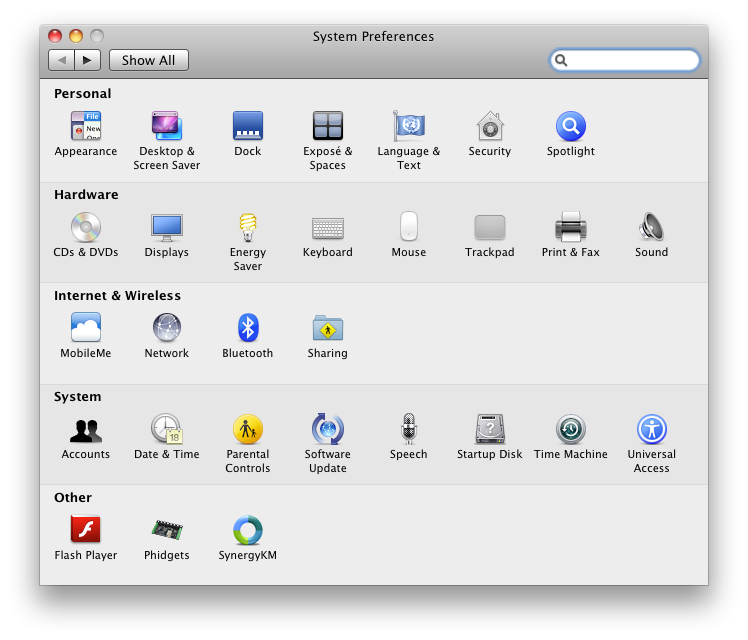
Click on the Phidgets icon in the Other section to bring up the Phidgets Preference Pane.

The Phidget Preference Pane can:
- Access and test Phidgets connected to your computer
- Update device firmware
- Access other Phidgets over the webservice, and make your local Phidgets accessible over the webservice
- Make use of the Phidget Dictionary
- Manage the labels of connected Phidgets
- View all SBCs on the network and view their webpages
For more information, visit the Phidget Preference Pane page.
Checking
To confirm the libraries were installed and work correctly, you can check both the hardware and software components of the interface. It is worth checking the software side first, because if it works then you know the hardware side is also okay.
Software
If you have the Phidgets library installed on your system, you can verify that the software component is working by seeing if the Phidget device is listed in the General tab of the Phidget Preference Pane.

The above screenshot shows that a PhidgetRFID and a PhidgetInterfaceKit are attached to the computer. If you see your Phidget in the list, you can continue to the programming languages section to learn more. If you are not able to see that the Phidget is in the list, there may be a hardware issue. Please see the hardware section for more details.
Hardware
You can verify that your computer detects that the Phidget is plugged in through a USB connection by going to the OS X System Profiler. You can access the System Profiler by selecting About This Mac under the Apple icon.

The new window will open up.
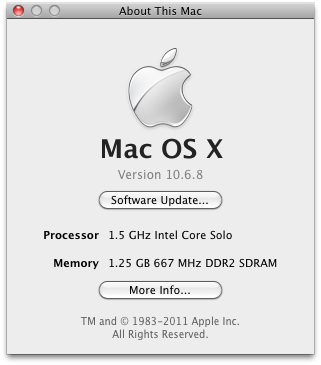
Select More Info. The System Profiler will show up. In the USB section, you will be able to find all connected USB devices.
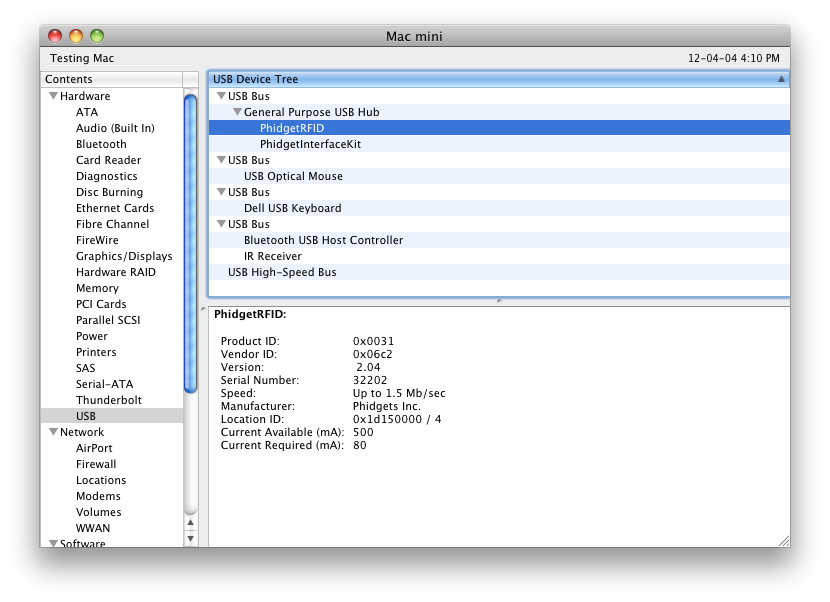
In the above screenshot, The PhidgetInterfaceKit and PhidgetRFID are connected to the USB ports.
If you don't see the Phidget in the list, then take a look at the troubleshooting section below, as well as the Communications section of our general troubleshooting page.
Troubleshooting
If the example programs do not work but USB does work (i.e. your computer can consistently see the device in the hardware), take a moment to check the basics:
- You are using OS X 10.4 or newer.
- No other programs, drivers, or processes are using that USB port in software
- The Phidget libraries are the latest version (visit the quick downloads section to download them)
- Check the common problems section below, some specific combinations can cause problems
If your problem doesn't seem to be fixed by these steps, make sure that the Phidget is seen consistently by USB (if it is erratic, try our general troubleshooting guide). If you are still having problems after using the troubleshooting guide, please ask us!
Programming Languages
Phidgets’ philosophy is that you do not have to be an electrical engineer in order to do projects that use devices like sensors, motors, motor controllers, and interface boards. All you need to know is how to program.
After you have installed the drivers above, you should pick a programming language, install libraries, and run the examples for that specific language. You can learn more about what is needed to program in a particular language by choosing the language of your preference below. If you need help choosing a language, please look at the language comparison table.
We recommend the following languages for OS X:
You can also use these languages, but they do not support event driven code, and must use logic code only:
WebService
The Phidget WebService allows you to remotely control a Phidget over a network.
Drivers for the Phidget WebService on OS X are already included in the Drivers above. If you see the Phidget Preference Pane in System Preferences, then you already have the WebService drivers installed.
There are two ways that you can connect to a Phidget hosted on another computer. The first method is by using the IP address/host name and port of the host computer. The second method makes the use of mDNS, which allows Phidgets to be found and opened on the network by a server id instead of an IP address/host name. When using a server id, both the client and server will need to be running an implementation of zero configuration networking. The Phidget WebService takes advantage of Bonjour software, which is built-in to OS X. It is a tool developed by Apple to locate devices, such as Phidgets, on a network.
This section helps you install, check, and use the WebService on Windows, but we also have an overview of the Phidget WebService in general.
Turning the WebService On and Off
There are two methods that can be used to turn the WebService on and off. The first method is through the Phidget Preference Pane. In the WebService tab, you can start or stop the WebService. You can also choose to have the WebService start up automatically upon system boot up by selecting the Start Automatically checkbox.
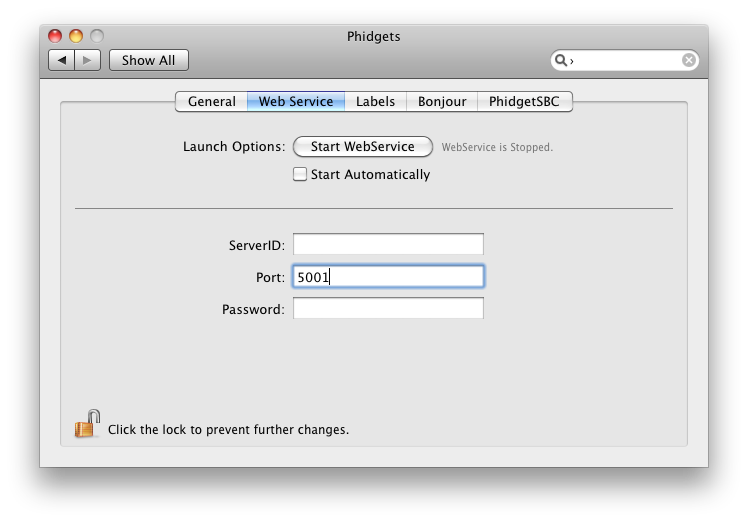
The second method of turning the WebService on and off is through command line. After using our installer, the WebService utility is automatically installed in /usr/bin/phidget21webservice.
You can get command line help with phidgetwebservice21 using the -h option:
phidgetwebservice21 -h
'phidgetwebservice21' is a Phidget and Dictionary server from Phidgets Inc. See www.phidgets.com for more information.
Usage: phidgetwebservice21 [OPTION]
All parameters are optional. The default parameters are: port=5001, ServerName=(Computer Name) and no password
Options:
-p Port
-n Server Name
-P Password
-v Debug mode
-h Display this help
Mapping out which command line options to which Phidget Preference Pane option is as follows:
-p: Port field
-n: ServerID field
-P: Password field
-v: Not supported under the Phidget Preference Pane
To find the defaults used by phidget21webservice, the command line is the fastest way to learn the default server name and IP address of your computer:
- For the default server name, use
hostnameon the command line. - For your IP address, use
ifconfig -aon the command line.- A line in the return text, under your main internet connection (usually
eth0) will say something likeinet addr:192.168.3.178, which is your IP.
- A line in the return text, under your main internet connection (usually
Here are some usage examples:
To start the WebService with default parameters:
phidgetwebservice21
To start the WebService with a server name of myServer:
phidgetwebservice21-n myServer
To stop the WebService, simply close the command line window or press Control and c at the same time in the command line window.
Using the WebService
To use a Phidget over the WebService, you'll want to:
- Have two different computers connected to the same network. We will call the computer that has the Phidget directly connected to the USB port the host. The client will be the computer that runs a Phidget application to connect to the Phidget attached to the host. Please note that if you only have a single computer, you can also connect to the Phidget over the WebService. The computer will simply act as both a host and client. This will allow you to bypass the one application per Phidget limitation.
- Start the WebService on the computer that directly connects to the Phidget
- Run your program on the remote computer that will control the Phidget over the network
The easiest way to test these steps on OS X is to set up the WebService and run the Phidget program on the client. Please follow these steps:
1. On the host, open up the Phidget Preference Pane and traverse to the Web Service tab.

2. Leave all fields the way they are, and click on Start WebService to run the WebService.
3. You can determine that the WebService is running by looking at the status on the right side.
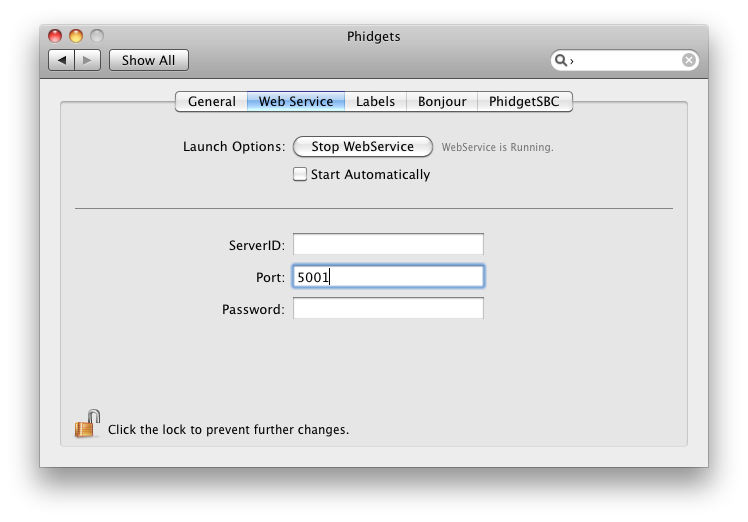
4. Ensure that the Phidget is plugged in to the host.
5. On the client's Phidget Preference Pane, open up the Bonjour tab. You will see the Phidget that is plugged into the host as one of the entries listed. Double click it to open the example application.
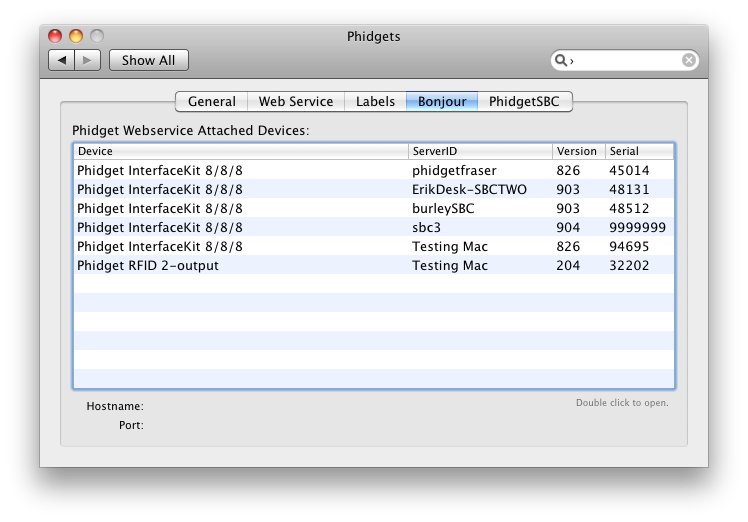
6. The example application will open up, and you will be able to communicate with the Phidget over the WebService.
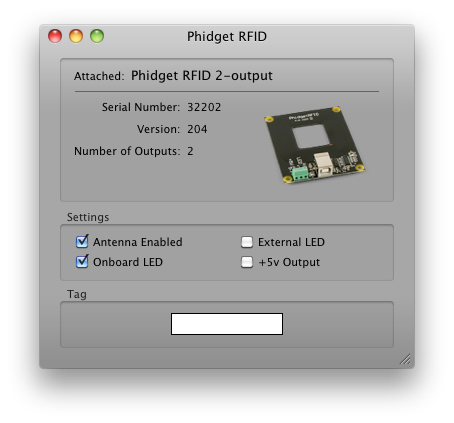
7. You can confirm that the WebService was indeed behind this exchange by terminating the WebService process while still allowing the remote program to run. On the host's Phidget Preference Pane, traverse to the WebService tab. Hit Stop WebService to terminate the WebService.

8. Take a look at the example application on the client. Since the application can no longer connect to the WebService, there is nothing attached.
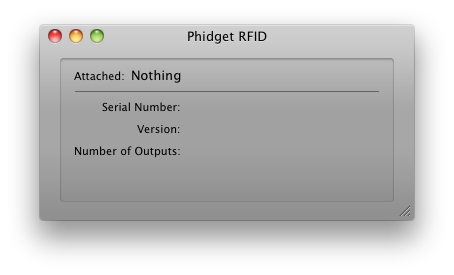
Debugging the WebService
In addition to enabling logging in your Phidget code, you can get additional debugging information from the WebService itself. This additional debugging can only be enabled from the command line approach to start the WebService. Debug information is enabled by specifying the -v option:
phidgetwebservice21 -v -n "myServer"
The debugging information will be shown as output in the command line console.
Advanced Uses
Appendix
Description of Installer files
Here is the list of files and their description for each file the installer puts onto your system.
Description of Library files
This section will explain the files that were placed onto your system as part of the installation process.
Phidget21.frameworkcontains the actual Phidget library, which is used at run-time. It is placed into/Library/Frameworks.Phidget.kextis the kernel extension. It is placed into/System/Library/Extensions.libphidget21.jnilibis the JNI library for Java. It is placed into/Library/Java/Extensions.Phidgets.prefpaneis the Phidgets Preference Pane. It is placed into/Library/PreferencePanes.phidgetwebservice21is the Phidget WebService. It is placed into/usr/bin.PhidgetsOSA.appis the the Phidgets agent for AppleScript. It is placed into/Library/ScriptingAdditions.
Common Problems and Solutions
None, yet.
